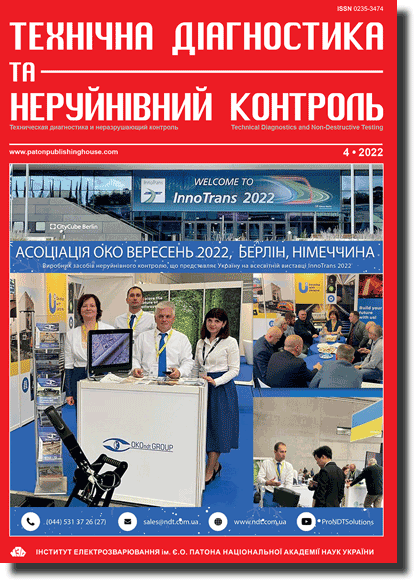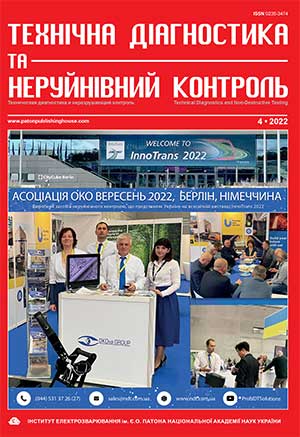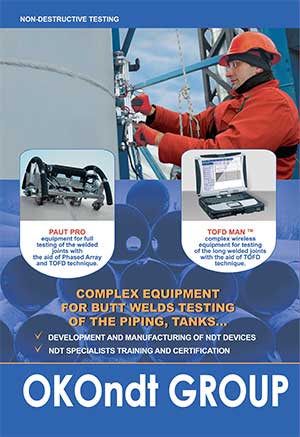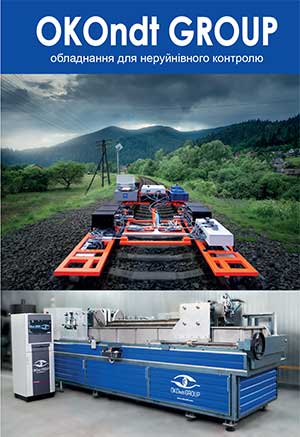| 2022 №04 (03) |
DOI of Article 10.37434/tdnk2022.04.04 |
2022 №04 (05) |
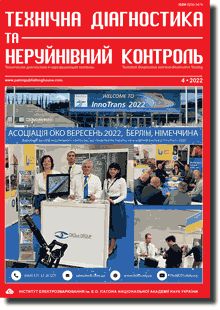
"Tekhnichna Diahnostyka ta Neruinivnyi Kontrol" (Technical Diagnostics and Non-Destructive Testing) #4, 2022, pp. 27-32
Reducing the level of interference at thermal non-destructive testing considering the specific thermal physical and morphological characteristics of the object
V.O. Storozhenko, S.M. Meshkov, R.P. Orel, O.V. Miahkyi
RTC «Thermocontrol» of Kharkiv National University of Radio Electronics. 14 Nauky Ave., 61166, Kharkiv, Ukraine. E-mail: volodymyr.storozhenko@nure.uaInterferences, characteristic for non-destructive thermal testing which reduce the reliability of the results obtained are described. A technique for their reduction is suggested which consists of two interrelated stages. The fi rst stage consists in calculating and analyzing the nature and level of the expected signal according to the developed thermophysical model against the background of the experimentally obtained noise level. According to the results of analysis of calculations using the thermophysical model for the selected samples, the most infl uential interference was the inhomogeneity of the emissivity of the sample surface. The second stage of processing the received data is devoted to reducing this noise. This stage consists in processing of thermograms of temperature fi elds and includes morphological analysis of the surface condition, fi ltering and reducing characteristic noise and interference. It consists of four practical procedures: analysis of the visual image and obtaining a map of zones with diff erent emissivity of the sample surface, analysis of the thermogram with an assessment of the level of discreteness of the thermogram and the position of fi ducial points on the image, smoothing the thermographic image and highlighting zones on the thermogram with diff erent emissivity of the controlled object surface, after which the noise is fi ltered. Since the results of thermal control are strongly infl uenced by the shape of the object, the possibilities and eff ectiveness of the suggested technique are illustrated on a cylindrical object. It has been experimentally confi rmed that for the selected sample, it was possible to reduce the noise level to that of confi dent separation of useful signal against the noise background. Ref. 10, Fig. 5.
Keywords: thermal non-destructive testing, useful signal level, structural noise, thermophysical model, image processing, morphological analysis
Received: 29.08.2022
References
1. Vavilov, V.P. (2009) Infrared thermography and thermal control. Moscow, Spektr [in Russian].2. Storozhenko, V.A., Maslova, V.A. (2004) Thermography in diagnostics and nondestructive testing. Kharkov, Smit [in Russian].
3. Xavier, P.V. Maldague (2001) Theory and Practice of Infrared Technology for Nondestructive Testing. John Wiley & Sons, Inc.
4. Pragnan Chakravorty (2018) What is a Signal? IEEE Signal Processing Magazine. Vol. 35, Issue 5, 175-177. https://doi.org/10.1109/MSP.2018.2832195
5. Storozhenko, V.A., Malik, S.B., Myagky, A.V. (2008) Optimization of modes of thermal flaw detection based on thermophysical modeling. Visnyk NTU KhPI, seriya «Elektroenergetyka ta Peretvoryuvalna Tekhnika», 48, 84-91 [in Russian].
6. Storozhenko, V.A., Myagky, A.V., Malik, S.B., Tikhy, V.G. (2013) Optimization of the procedure of thermal flaw detection of honeycomb structures. Tekh. Diagnost. i Nerazrush. Kontrol, 3, 31-35 [in Russian].
7. Myagky, A.V., Lazorenko, O.V., Storozhenko, V.A. (2013) Processing the results of thermal flaw detection of honeycomb structures to reduce the level of interferences. Visnyk NTU KhPI, seriya «Elektroenergetyka ta Peretvoryuvalna Tekhnika», 34, 108-122 [in Russian].
8. Storozhenko, V., Myagkiy, A., Orel, R. (2016) Оptimization of the procedure of thermal flaw detection of the honeycomb constructions by improving the accuracy of interference function. Eastern-European J. of Enterprise Technologies, 5, 12-18. https://doi.org/10.15587/1729-4061.2016.79563
9. Basim Alhadidi, Mohammad H. Zu`bi, Hussam N. Suleiman (2007) Mammogram breast cancer image detection using image processing functions. Information Technology J., Vol. 6, Issue 2, 217-221. https://doi.org/10.3923/itj.2007.217.221
10. Solomon, C.J., Breckon, T.P. (2010) Fundamentals of Digital Image Processing: A Practical Approach with Examples in Matlab. Wiley-Blackwell. https://doi.org/10.1002/9780470689776
Advertising in this issue:
The cost of subscription/purchase order journals or individual articles
| Journal/Currency | Annual Set | 1 issue printed |
1 issue |
one article |
| TPWJ/USD | 384 $ | 32 $ | 26 $ | 13 $ |
| TPWJ/EUR | 348 € | 29 € | 24 € | 12 € |
| TPWJ/UAH | 7200 UAH | 600 UAH | 600 UAH | 280 UAH |
| AS/UAH | 1800 UAH | 300 UAH | 300 UAH | 150 UAH |
| AS/USD | 192 $ | 32 $ | 26 $ | 13 $ |
| AS/EUR | 180 € | 30 € | 25 € | 12 € |
| SEM/UAH | 1200 UAH | 300 UAH | 300 UAH | 150 UAH |
| SEM/USD | 128 $ | 32 $ | 26 $ | 13 $ |
| SEM/EUR | 120 € | 30 € | 25 € | 12 € |
| TDNK/UAH | 1200 UAH | 300 UAH | 300 UAH | 150 UAH |
| TDNK/USD | 128 $ | 32 $ | 26 $ | 13 $ |
| TDNK/EUR | 120 € | 30 € | 25 € | 15 € |
AS = «Automatic Welding» - 6 issues per year;
TPWJ = «PATON WELDING JOURNAL» - 12 issues per year;
SEM = «Electrometallurgy Today» - 4 issues per year;
TDNK = «Technical Diagnostics and Non-Destructive Testing» - 4 issues per year.





